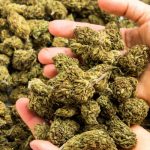You might call Jerry Munn’s Lime Volt cannabis the champagne of marijuana country.
The Northern California farmer, who’s cultivated pot for over 28 years, gets positively electric describing his new botanical creation. “It’s tingling to the senses and stimulates the sinuses,” says Munn. “People have told me it’s like smoking a margarita.”
The Mendocino County farmer, who lives in the heart of the renowned Emerald Triangle, knows he’s created a winning weed varietal. For over half a century, that region of the state has been lauded the world over for producing some of the finest cannabis on the planet.
Since well before January of 2018, when legal recreational cannabis sales kicked off in California, the state has been aware that farmers — particularly small-batch, craft cannabis growers — have sought to establish appellation designations for their crops. In the same way that vintners have set their products apart from other wine makers based on geographical regions (think Bordeaux, Champagne and Napa), marijuana producers are looking to cash in on a similar status for their celebrated areas.
As legal marijuana enters a new, credible age in the U.S., its connoisseurs are maturing right along with the industry. Today, cannabis users are increasingly looking for interesting pot varietals — called strains — that contain great taste profiles with highly nuanced characteristics. Those flavorful and individual features are a result of specific growing conditions that arise from distinct microclimates and terrain. Now a movement is occurring in California to make the most of those pot strains via “appellation of origin” designations that will protect both consumers and sellers alike.
Welcome to the era of marijuana elevated to the level of a luxury product, no different from fine wine.
“The counties of Mendocino, Humboldt and Trinity all have world-renown reputations for growing great cannabis,” says Munn, whose farm is located in Covelo, a town in Mendocino County. “This appellation has a rich cultivation history, nutrient-packed soil, a perfect microclimate and sparkling clean water from the Eel River Water Shed. All of which highly affects the final output and quality of our cannabis.”
Following in the footsteps of similar regulated bodies for wine — the Appellation d’Origine Contrôlée in France and the American Viticultural Area in the U.S. — California pot producers are seeking a similar degree of prestige based on their geography. An important marketing tool for savvy artisan weed growers, as the creation of appellations is occurring alongside a wave of commercial cannabis mega-farms that threatens to overwhelm the Golden State’s craft growers.
To support local licensed growers like Munn — many of whom live and work in small rural towns that are dependent on cannabis dollars — state regulators have prompted the California Department of Food and Agriculture (CDFA) to establish an appellation of origin system for cannabis cultivators no later than January 1, 2021. Rebecca Forée, a representative for CalCannabis Cultivation Licensing (a division of the CDFA responsible for regulating commercial cannabis cultivators in California), says they are in the early planning stages of the appellations project and are looking for grower input this September.
“We are in the process of developing a framework for the CalCannabis Appellations Project that will allow licensed cannabis cultivators in California to petition CDFA for the establishment of an appellation,” she says. Planning to hold six public workshops throughout the state this September, Forée says the organization looks to glean “suggestions from cannabis cultivators and other stakeholders on how to develop the framework for the appellations project.”
Once CalCannabis has heard from permitted marijuana producers in the state and gains a better understanding of what cultivators want and need, they will begin to develop the project’s framework and draft regulations. They then plan to share that information with the public for additional feedback via another series of statewide workshops.
Genine Coleman says she “absolutely” will attend those September workshops. Executive Director of the Mendocino Appellations Project(MAP), Coleman’s organization was formed in 2015 at a time when medical marijuana had already reached full maturity in California since becoming law through Prop 215 in 1996. Her association saw the need for appellations before recreational weed went live in 2018 and acted. She describes MAP’s formation as deriving from “a grass roots outreach to local farmers, extensive regional exploration and community discourse” which lead to the identification of 11 regional zones in Mendocino County. One of those appellations is the Covelo region.
Munn is, of course, pleased to hear that Covelo is represented in the conversation and that other rural areas across the state may now get the recognition they deserve. “There are some regions that are so rural that people have never heard of them,” he says. “And those places are where some of the best cannabis cultivation is happening.”
CalCannabis says they’ve just finalized the appellations workshop schedule, and plan to have it posted on CDFA’s Cultivation Licensing Division’s website under the Events and Activities section early next week.
(189)





Leave A Reply